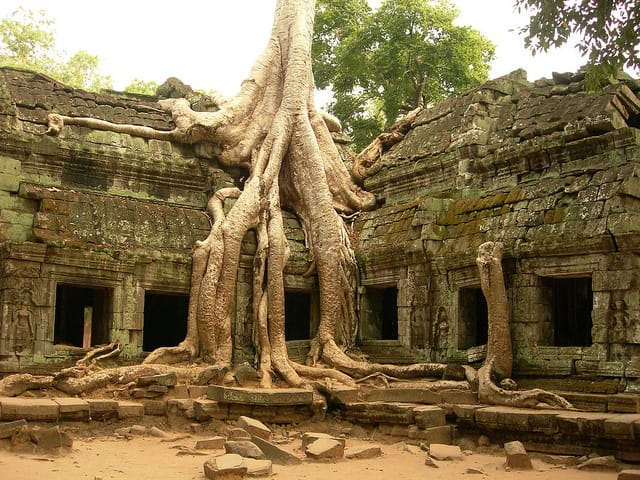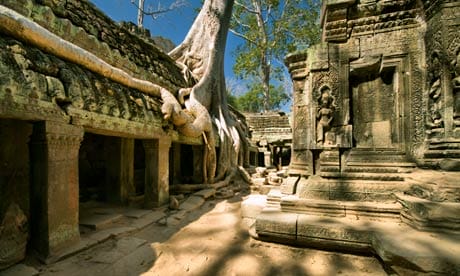Thanks to the decision to leave the jungle in place, Ta Prohm Temple has become one of the most iconic, evocative and photographed of all the ruins. Enormous kapok trees grow from its terraces and walls, their massive roots clinging to the walls, framing doorways and prising apart giant stones. None of the 39 towers is intact and the partly collapsed, maze-like state of the temple makes it difficult to plan a route or work out its layout, which is in fact on a single level, with three closely spaced galleried enclosures in the central area.
It doesn’t matter if you get a bit disoriented, though, since part of the charm of a visit here is in leaving the well-trodden paths to clamber over collapsed masonry and duck through caved-in galleries. The temple attracts plenty of visitors, but it’s usually quiet in the early morning, as mist rises off the algae-encrusted stones, or in the late afternoon, as the shadows lengthen.

Constructed by Jayavarman VII around 1186, Ta Prohm was a Buddhist monastery dedicated to Prajnaparamita, and would once have housed a statue of this deity in the image of the king’s mother (inscriptions say that a further 260 holy images were installed in surrounding chambers and niches). As a working monastery it accommodated twelve thousand people, who lived and worked within its grounds, while a further eighty thousand were employed locally to service and maintain the complex. Additionally, the monastery supplied provisions and medicines to the 102 hospitals that Jayavarman instituted around the kingdom.
The majority of visitors arrive from Ta Keo while on the Petit Circuit, approaching from the west, but if you use the track off the road northwest of Banteay Kdei, you can enter from the east as was originally intended. From Ta Keo, the path meanders off the road and under towering trees for around 300m until it reaches a collapsed causeway which leads across the moat to the ruined western gopura, topped by the four massive faces of a Bodhisattva.
Once through the gopura, you reach the three central enclosures, which take the form of galleries, by a paved causeway littered with broken statues and the remains of a naga balustrade. Moving quickly through the site, at the third enclosing wall, you can pause briefly to study the reasonably well-preserved gopura and roof of its colonnaded gallery.
Some of the most photographed trees in the world lie further in, scattered inside the second and first enclosures, particularly to the north and east. Few people can resist posing against the tree which crawls over the north side of the second enclosure’s gallery – though you can no longer clamber on to it. It’s easy to get so caught up in investigating the galleries and searching out new views of the trees that you actually miss seeing the central sanctuary, with collapsed towers at the corners. Remarkably, the carvings on the buildings are well preserved, almost as if nature has compensated for the overall destruction by preserving the details, which are well worth studying. The interior of the sanctuary is bare, but small holes in the walls indicate that it was once clad in wood or metal panels.







